Ten years ago Dynafit reps were lamenting the rise in popularity of the Fritschi Freeride. Interest in the US was just starting to pick up for Dynafit system and it seemed like the Freeride took the wind out of those sails. And then again with Marker’s Duke. But over that same period of time, many of those hard chargin’ freeriders realized the superiority of Dynafit for backcountry skiing and switched.
In fact, if you are a true backcountry aficionado I say you will end up in one of two camps: A Tech System binding with training heels – Dynafit, Plum, La Sportiva, Ski Trab – or telemark (perhaps with a Dynafiddle toe).
So, the only reason not to go Dynafit, is if you’re firmly in the “I don’t believe” camp, which is the same as the “I won’t believe” camp, or you’re just not sure you’re going to love backcountry skiing that much. The closer you get to 30 days per year earning your turns, the closer you are to being a free-heel Techie.
What follows is a semi-comprehensive look at the Dynafit system, while focusing on the new Radical series. With the new Radical, Dynafit makes noticeable improvements to how easy it is to latch in at the toe and switch to touring mode and engage the climbing posts.
Easier Entry
You may have noticed I’ve regularly referred to it as the Dynafiddle binding. Anyone who has ever used a pair knows getting in to the toe takes some practice and a bit of alignment luck/skill to snap into quickly. It’s not that difficult, except sometimes it still is, even with practiced users. Dynafit has developed two revisions to their system to improve this.
The first was the addition of a bumper of metal at the rear edge of the inserts. This creates a stopper to help align the inserts with the pins and is now standard on all Dynafit boots. It is patented so it is not available with any other brand using tech fittings. Bottom line, it helps reduce the fiddle factor when clicking in to any Dynafit toe.
Toe Improvements
The second improvement came with the Radical binding that sports a completely redesigned toe piece. There are several improvements, but the most obvious is the addition of two posts called Power Towers. These increase the overall burliness while simultaneously helping with boot- pin alignment – a nice improvement that helps the many customers whose feet aren’t fond of Dynafit boots, but still love their bindings and would like a more foolproof entry system. Experienced users may not consider it much easier, just different, because it favors sliding your foot forward and stepping down flat, instead of tipping your boot to one side, then angling down to the other side to lock in.
There are several other changes to the Radical toe piece. The mounting pattern is now a simpler, slightly wider 4-hole pattern. The mounting screws come with a Torx head (T20) instead of the ubiquitous Posi-drive head. Theoretically a Torx® bit is easier to come by. I’m reluctant to endorse this change. Posi-drive bits may not be as prevalent as Torx, but I’ve stripped Torx bits before, never a Posi-drive bit (er, not with the correct bit anyway ). 😉
One of the “improvements” of the Radical’s predecessor, Dynafit’s Vertical FT, was to widen the arms of the toe piece. While this was done to increase lateral control, it had the unfortunate side effect of reducing it because the plastic baseplate under the metal was not increased as well, leaving the toe arms less supported which allowed them to bend under extreme pressure,and/or prematurely release. There are two possible cures. Get the FT Powerplate to support the arms better, or upgrade to the Radical.
There are other, less obvious refinements to the Radical toe piece including the slot that crampons slide in to, it’s been improved to making it easier to put them on, or take them off.
Heel Improvements
To the average user, the changes in the toe may be important, but subtle. Changes at the rear of the Radical are more obvious, especially the change in the climbing post. As with any tech binding, the heel assembly still must be rotated to switch between a locked and a free heel. However, with every other tech binding, the height of the climbing post is determined by how far you rotate the heel. The first step gives a flat free heel, second a moderate climbing post, the third a high post, and four clicks around lines the binding back up to lock the heel.
With the new Radical heel you only need to rotate one position, clockwise, to free the heel. Once you’ve rotated it clockwise one click, approximately 90°, then one of two climbing posts can be flipped up or down with a light pull from a ski pole for a moderate or aggressive heel post. This is waaaay easier to do than trying to get your ski pole aligned in the volcano for rotating the heel piece.
Unfortunately this new system has it’s own set of flaws. One requires a change in operation, and the other a change in manufacturing. It turns out that the mating half of the hinge that the posts rotate on has been known to break (see page 2). For a small percentage of the bindings sold last year, Dynafit claims less than 1%, the metal in the climbing post hinge became embrittled and broke during normal use. The manufacturing process has been changed to prevent embrittlement of the parts from occurring, thus any Radical bindings shipped from Fall 2012 on should be immune from this potential defect.
Did I mention the Radical heel must be rotated clockwise? It will resist rotating counter clockwise so if you’re an experienced Dynafit user you might need to break the habit of being able to rotate the heel either way. If you force it counter clockwise on the Radical (2012 model), you could sheer the pin that locks the heel piece on the spindle it rotates on. (See page 2 for Dynafit’s explanation of the consequences and the fix.)
Don’t want to deal with this issue? Look for a rubber bumper on the port side of the ski brake which creates a physical block to rotating the wrong way. This is your clue that the heel is the updated 2013 model.
One quick note on ease of use. Rotating the heel has traditionally been done by inserting the tip of your pole in the climbing post. With the Radical though there is no hole to put your pole tip in, so you need to lean back and rotate the heel with your hand. Grrrrowl. Nobody likes doing that. To provide that same functionality, flip up the highest post and insert your pole in the “holes” of the high post to rotate the heel back to the downhill position after you rip the hide. Otherwise you have to lean back and twist with your hand, a manoeuvre that few are comfortable with.
How Rad to be?
In spite of these two complications with the Radical heel, the odds are that this is the easiest to use, and thus the most desirable Dynafit binding ever produced. The real question is which version of the Radical should you get, the FT, ST, or Speed? If you really do charge hard, get the FT. This is the heaviest of the 3 models with a carbon fiber “plate” between the toe and heel for increased control. I find it hard to believe it does anything but increase psychological confidence, but there are times even that can have value. More importantly is the fact that the arms of the toe are fully supported by the toe shim. Plus Dynafit has added some vibration absorbing rubber.
If you don’t need psychological support, nor the extra support on the toe arms, go with the ST. If light is the most important criteria, go for the Speed, just remember it doesn’t come with ski brakes. My only complaint is Dynafit doesn’t offer a toe shim with full support on the toe arms with the ST. Perhaps next season?
If you’re ready to commit to earning your turns in the backcountry, don’t waste your time or money on heavier gear. Go with a tech system, and if you’re new to the game, don’t waste your time with older Dynafit models unless you’re shopping the used market. Otherwise, get the Radical. Unless you’re in the 1%, you won’t regret it.
Dynafit
Radical FT
MSRP: $599
Weight/foot: 1 lb. 5 oz. (599 g)
Radical ST
MSRP: $499
Weight/foot: 1 lb., 3 oz. (531 g)
Radical Speed
MSRP: $399
Weight/foot: 12 oz. (341 g)
© 2012
Pages:
- 1
- 2



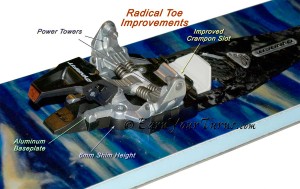
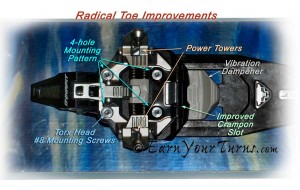
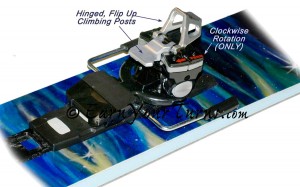
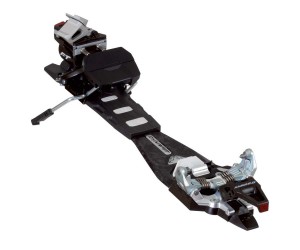
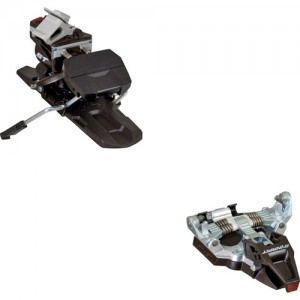
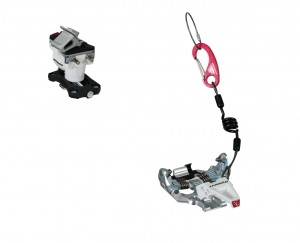
9 pings
Skip to comment form
[…] a straight down, or flat alignment with your boot toe is noticeably easier than with a classic Dynafit, or La Sportiva binding. Certainly easier than the classic, fiddly method of hooking one side then […]
[…] but the instinctive reaction is to stomp, a reaction that is certain to test the durability of a Radical climbing post but probably won’t phase the […]
[…] resulted in a polarized market. Experienced backcountry skiers know that light is right so they buy Dynafit or tech bindings that are knock-offs of the original, patented Dynafit concept. On the other hand, […]
[…] especially if you own them but left ‘em behind. Dynafit is still your best choice, either the Radical ST or, if you can find ‘em, the Vertical ST. Plum’s Guide or Yak are nice bindings that […]
[…] king of the hill, Dynafit has hardly been sitting on their laurels lately. Two seasons ago the Radical was introduced, with power-towers for easier toe alignment and thus entry, and a heel piece that […]
[…] requires. Some require less, some more. It’s why Dynafit developed their Power Towers in the Radical series toes, to make snapping in at the toe easier. So what’s your fiddle factor and how much […]
[…] As soon as you start going long, either on big days, or several consecutive days fully earning each turn, the weight will wear on you – especially if you’re breaking trail in deep snow. When you get to that stage know two things. First, you’re hooked, and two, you can chop weight without even adjusting your technique, all it takes is mo’ money (for a tech system). […]